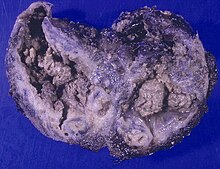You can helpexpand this article with text translated fromthe corresponding articlein French.(October 2024)Click [show] for important translation instructions.
|
Anaspergillomais a clump ofmoldwhich exists in a body cavity such as aparanasal sinusor an organ such as thelung.By definition, it is caused byfungiof thegenusAspergillus.[1]
| Aspergilloma | |
|---|---|
| Other names | Mycetoma, fungus ball, moldy lungs |
 | |
| Aspergillomas complicating tuberculosis: multiple aspergillomas within large cavitary lesions of tuberculous origin. | |
| Specialty | Infectious disease |
| Causes | Aspergillusfungal infection |
| Diagnostic method | Chest x-ray show tumour like opacity. Serology can be helpful. Fungal hyphae seen on KoH mount and sputum culture grows fungus |
| Frequency |
|
Signs and symptoms
editPeople with aspergillomata typically remainasymptomaticuntil the condition is fairly advanced; in some cases even for decades.Diagnosisis often made as a result of anincidental findingon a chest X-ray orCT scanthat may be performed as part of the workup for another unrelated condition. However, a small percentage of aspergillomata invade into a blood vessel which can result in bleeding. Thus, the most common symptom of associated with aspergillomata is coughing up blood (hemoptysis). This may result in life-threatening hemorrhage, though the amount of blood lost is usually inconsequential.[citation needed]
Aspergillomata can also form in other organs. They can formabscessesin solid organs such as the brain or kidney, usually in people who are immunocompromised. They can also develop within body cavities such as the sphenoid or paranasal sinuses,[2]theear canal,and rarely on surfaces such asheart valves.[citation needed]
Cause
editThe most common organ affected by aspergilloma is the lung. Aspergilloma mainly affects people with underlyingcavitary lung diseasesuch astuberculosis,sarcoidosis,bronchiectasis,cystic fibrosisand systemicimmunodeficiency.Aspergillus fumigatus,the most common causative species, is typically inhaled as small (2 to 3micron)spores.The fungus settles in a cavity and is able to grow free from interference because critical elements of theimmune systemare unable to penetrate into the cavity. As the fungus multiplies, it forms a ball, which incorporates dead tissue from the surrounding lung, mucus, and other debris.[3]
Diagnosis
editDiagnosis of aspergilloma is by serum IgE levels which are usually raised in this condition.
Treatment
editMost cases of aspergilloma do not require treatment.[citation needed]Treatment of diseases which increase the risk of aspergilloma, such as tuberculosis, may help to prevent their formation. In cases complicated by severe hemoptysis or other associated conditions such aspleural empyemaorpneumothorax,surgery may be required to remove the aspergilloma and the surrounding lung tissue by doing a lobectomy or other types of resection and thus stop the bleeding. There has been interest in treatment with antifungal medications such asitraconazoleandvoriconazolewith some reports showing aspergilloma eradication.[4]
Although most fungi—and especiallyAspergillus—fail to grow in healthy human tissue, significant growth may occur in people whoseadaptive immune systemis compromised, such as those withchronic granulomatous disease,who are undergoingchemotherapy,or who have recently undergone abone marrow transplantation.Within the lungs of such individuals, the fungalhyphaespread out as a spherical growth. With the restoration of normal defense mechanisms,neutrophilsandlymphocytesare attracted to the edge of the spherical fungal growth where theylyse,releasing tissue-digesting enzymes as a normal function. A sphere of the infected lung is thus cleaved from the adjacent lung. This sphere flops around in the resulting cavity and is recognized on x-ray as a fungus ball. This process is beneficial as a potentially serious invasive fungal infection is converted into surface colonization. Although the fungus is inactivated in the process, surgeons may choose to operate to reduce the possibility of bleeding. Microscopic examination of surgically removed recently formed fungus balls clearly shows a sphere of dead lung containing fungal hyphae. Microscopic examination of older lesions reveals mummified tissue which may reveal faint residual lung or hyphal structures.[5]
References
edit- ^"Aspergilloma".Medical Dictionary.TheFreeDictionary.
- ^"Life".Archived fromthe originalon 2017-06-22.Retrieved2014-10-21.
- ^Soubani AO, Chandrasekar PH (June 2002)."The clinical spectrum of pulmonary aspergillosis".Chest.121(6): 1988–9.doi:10.1378/chest.121.6.1988.PMID12065367.Archived fromthe originalon 2013-04-14.
- ^Capone, A.; Di Bella, S.; Chinello, P.; Chiappetta, D.; Campoli, C.; Petrosillo, N. (2013)."Multiple Bilateral Pulmonary" Fungus Balls "in an Immunocompetent Patient Unsuitable for Surgical Treatment: Efficacy of Azoles Treatment".Mycopathologia.175(3–4): 361–363.doi:10.1007/s11046-013-9639-y.ISSN0301-486X.
- ^Przyjemski, CJ; Mattii, R (1980)."The Formation of Pulmonary Mycetomata".Cancer.46(7): 1701–1704.doi:10.1002/1097-0142(19801001)46:7<1701::AID-CNCR2820460733>3.0.CO;2-4.PMID6932257.